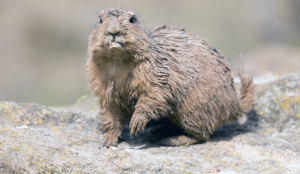What to do if a groundhog is not scared of people, acting strange or is aggressive?
HANDLING STRANGE-ACTING GROUNDHOGS

Every animal, just like humans, has certain rights that prevent its extinction and allow it to exist freely. These rights include the five basic animal freedoms, which are:
- Freedom from thirst and hunger,
- Freedom from discomfort,
- Freedom from pain, injury or disease,
- Freedom from fear and distress,
- Freedom to express innate behavior.
Like every human right, animal rights are to be guarded and upheld by the law, and violation of this can invite dire consequences. However, there are limits to the expression of these rights within the law, and these must never be crossed.
Groundhogs (Marmota monax)
These are a species of small animals related to squirrels, with similar behavioral characteristics. They mostly feed on vegetables and are a threat to gardens and farms. Groundhogs are also referred to as woodchucks, whistle pigs, land beavers, or marmots.
Though groundhogs prefer to burrow and stay underground almost throughout summer, they are tree climbers and can easily navigate walls. They are highly sensitive and intelligent animals and hate foul-smelling places.
They live in burrows underneath the ground and are highly social animals, known for their loud whistle to warn others of danger, and a nose rub in greeting often referred to as an “Eskimo kiss.”
Strange Behaviors
Groundhogs, like most other wild animals, generally avoid humans and other larger animals. Their harmful effects are often seen in the destruction of gardens and farms, consumption of food in storage, or creation of burrows on property.
While wild animals are very unlikely to engage with humans, this might occur when they feel threatened, startled, sick or sense danger from humans.
Additionally, groundhogs, like most wild animals, are exposed to infection and disease in the wild and can become a transmission source to man and domestic animals. One common disease that occurs in groundhogs is rabies, which can be transmitted by contact with an
infected animal.
A rabid marmot is likely to initiate an attack on animals or humans with no provocation, bite on tree barks and inanimate objects, and be aggressive and unapproachable. This becomes a safety hazard to man and other animals, especially since rabies is zoonotic and almost without a cure.
Tips on Handling Strangely Acting Groundhogs
 Build fences:
Build fences:
Although groundhogs are known to be excellent tree climbers, they prefer to burrow their way through distances and eat as much vegetation as is close to the ground. Building a fence around your garden may keep them out if there is easier access to food elsewhere.- Clear bushes:
An easy hideout is thick and long grasses where you can find not just groundhogs but other vermin as well. Clearing of bushes reduces the risk of lurking spots for groundhogs. - Safety first:
Never engage a groundhog on your own, even when it looks harmless and unguarded. As highly intelligent animals, they sense danger from afar and attack instinctively. - Contact appropriate bodies:
When you discover an aggressive groundhog in your yard, immediately contact your wildlife control agency or pest control for immediate action. - Dislodge:
Make staying in your yard very uncomfortable for groundhogs. You can fill up their burrow entrance with foul-smelling items or change your yard’s look. This causes them to be nervous and can be effective in driving them away.
Groundhogs hibernate almost half of the year but cause a lot of trouble when out of hibernation. However, they can be controlled and co-exist with humans if the above methods are used.

 Build fences:
Build fences: